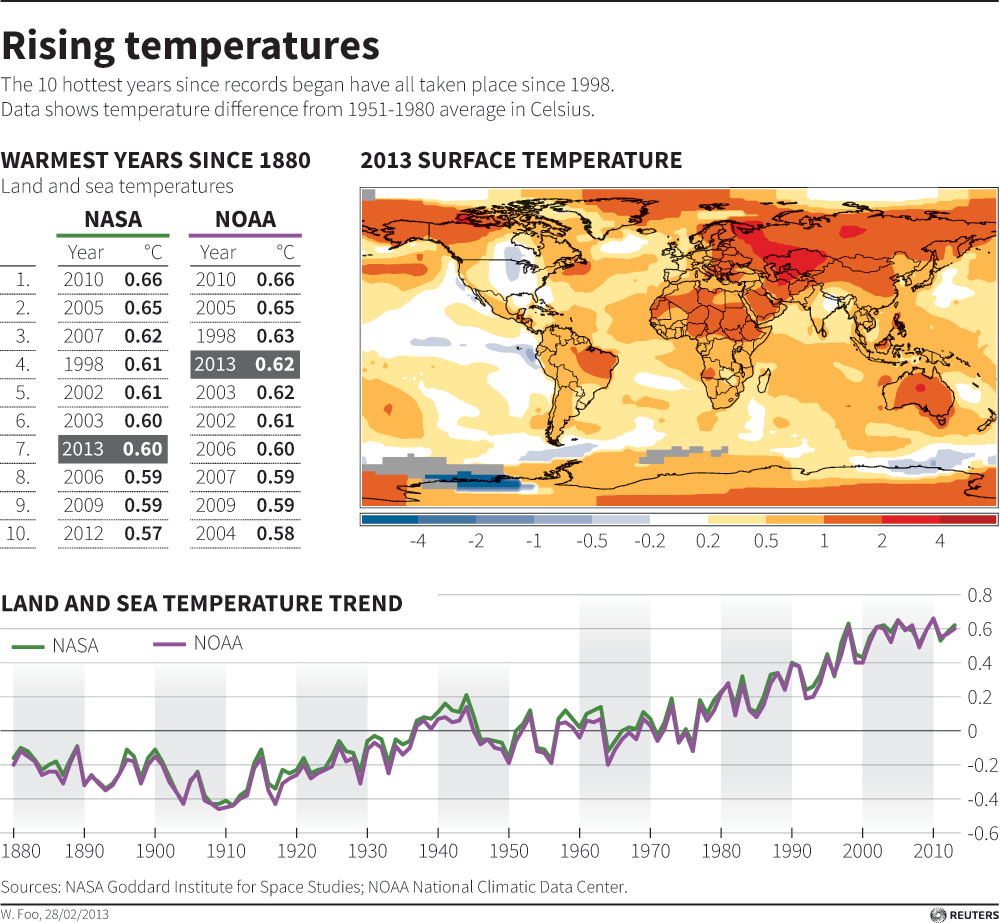One important takeaway from the new National Climate Assessment study released Tuesday is this: If Congress continues to refuse to act on curbing greenhouse gas emissions, cities and other urban centers will have little choice but to undertake costly infrastructure and flood control projects to protect against the mounting threats of devastation and death.
The report by a blue-ribbon panel of scientists on effects of human-induced climate change found that adverse effects are being experienced in virtually every area of the country, from heat waves and drought in the Southwest to torrential rains and mega-storms in the Midwest and Northeast.
Related: How Climate Change Is Affecting Your Region

“Climate change, once considered an issue for a distant future, has moved firmly into the present,” the scientists and climate experts wrote in the National Climate Assessment unveiled today by the White House.
These sweeping changes have been triggered by an average warming of less than 2 degrees Fahrenheit over most land areas of the country in the past century, according to the report. However, if greenhouse gases such as carbon dioxide and methane continue to escalate at a rapid pace, they said, the warming could conceivably exceed 10 degrees by the end of this century.
“Climate change and its impacts threaten the well-being of urban residents in all regions,” the report says. “Essential infrastructure systems such as water, energy supply and transportation will be compromised increasingly by interrelated climate change impacts. The nation’s economy, security and culture all depend on the resilience of urban infrastructure systems.”
The report also said, “Approximately 245 million people live in U.S. urban areas, a number expected to grow to 364 million by 2050. Paradoxically, as the economy and population of urban areas grew in past decades, the built infrastructure within cities and connected to cities has deteriorated, becoming increasingly fragile and deficient.”
The report comes amid fresh memories of the 2012 Superstorm Sandy devastation – the largest Atlantic hurricane on record that killed at least 286 people and wrought more than $68 billion of damage in New Jersey, New York and elsewhere.
Related: American Infrastructure Gets a New Wakeup Call
New York City officials are debating massive and costly projects to abate future storm surges and flooding, such as seawalls and underground flood control gates – but those would cost potentially tens of billions of dollars or more to construct. Nationwide, city and county officials have little choice but to face up to the inevitability of a new era of infrastructure construction – not unlike the boom in interstate highway construction during the 1950s and 1960s.

“Over the long term, responses to severe climate change impacts, such as sea level rise and greater frequency and intensity of other climate-related hazards, are of a scale and complexity that will likely require major expenditures and structural changes, especially in urban areas,” the climate change report said. “When major infrastructure decisions must be made in order to protect human lives and urban assets, cities need access to the best available science, decision support tools, funding, and guidance.”
Related: A Rising Tide of Natural Disasters as Climate Changes
The report doesn’t attempt to put a price tag on the nation’s long-term infrastructure needs to protect against the impact of climate change. Among the report’s key findings are these, as noted in the report:
- In urban settings, climate-related disruptions of services in one infrastructure system will almost always result in disruptions in one or more other infrastructure systems.
- Climate vulnerability and adaptive capacity of urban residents and communities are influenced by pronounced social inequalities that reflect age, ethnicity, gender, income, health, and disability differences.
- City government agencies and organizations have started adaptation plans that focus on infrastructure systems and public health. To be successful, these adaptation efforts require cooperative private sector and governmental activities, but institutions face many barriers to implementing coordinated efforts.
Climate change has received scant attention in Washington since the early days of President Obama’s first term, when congressional Republicans thwarted Democratic efforts to pass a “cap and trade” proposal that would use penalties and financial incentives to curb industrial greenhouse-gas emissions. Senate Democratic leaders shelved Obama’s ambitious plan in July 2010 after failing to muster a 60-vote supermajority needed to pass the legislation.
With no leadership from Washington, California and other states took steps of their own to address climate change issues. “The administration now hopes to use the report to shore up public support for the president’s climate policies as he attempts to put new regulations in place to limit emissions from coal-fired power and industrial plants,” The New York Times reported this morning.
A major political battle over the rules is expected this summer, with Republicans already accusing Obama of plotting a “war on coal.”
Top Reads from The Fiscal Times:





